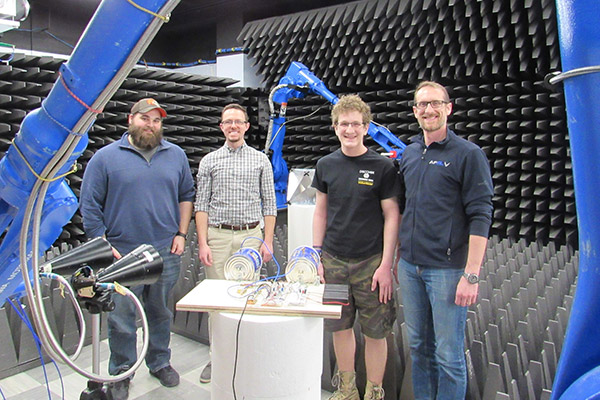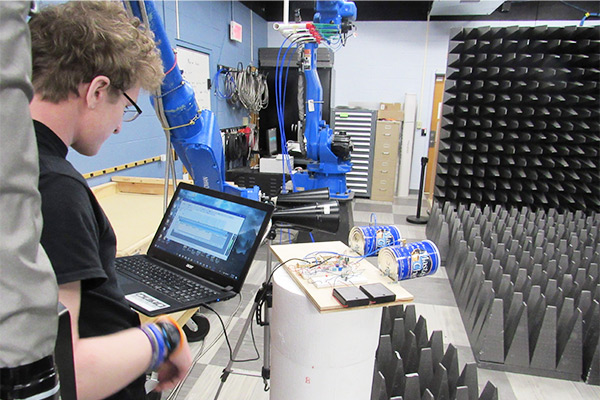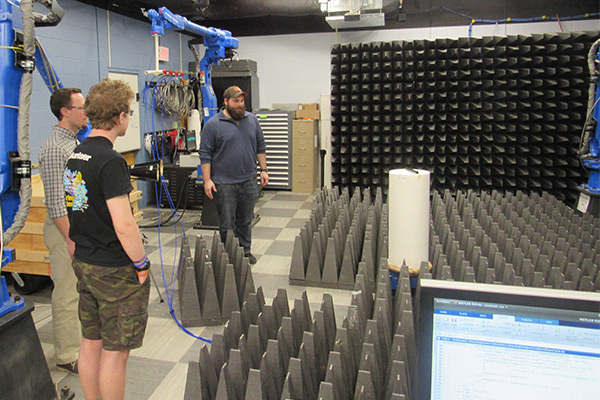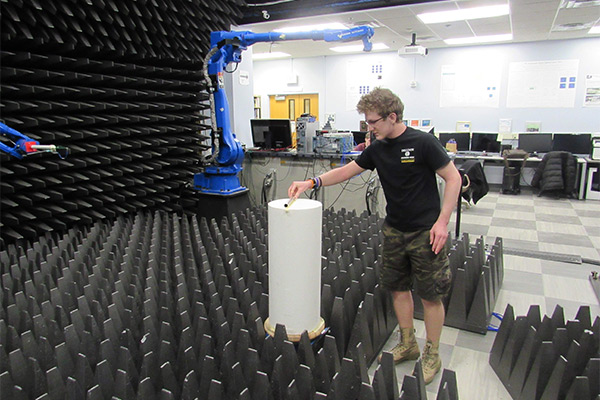Dayton Engineer

Research for the Common Good: Mumma Radar Lab Advances Student Research on Radar Reaction to Drones
By Karen Updyke, School of Engineering
Dr. Michael Wicks, director of the University of Dayton’s Mumma Radar Lab, opened the doors to the University's Kettering Laboratories for a student researcher who wants to make a difference.
Bellbrook High School student, Kaiden (Kai) Delsing, needed a lab with high-level capabilities to test his research on radar reaction to drones.
Kai’s Inspiration
Two years ago, Kai’s experiments began after he watched the movie “Sully,” which was about the January 15, 2009, emergency airplane landing on New York’s Hudson River after the engines were struck by geese. Captain Chesley “Sully” Sullenberger landed the plane and all passengers and crew were safe. The incident prompted Kai to experiment on improvements in radar detection for prevention of aircraft bird strikes.
To start, Kai interviewed pilots and found that they had a greater concern – drones.
Mumma Radar Lab Team
As a science fair project, Kai recreated radar reactions to various materials that could be used to make drones. He purchased four carbon fiber arms currently used in drone construction and kept one, unaltered, as his baseline. Two of the arms he taped, one with copper and another with aluminum tape. The third arm, he sprayed with aluminum paint.
At this point, the University of Dayton Mumma Radar Lab opened its doors to help Kai with his experiments and to positively benefit aviation, aircrafts and pilots.
Alex Burwell, research engineer with the Lab and with the Air Force Research Lab (AFRL), facilitated the team of researchers: Burwell; Kai, Kai’s father, Frank Delsing, AFRL; Andrew Bogle, University of Dayton Research Institute (UDRI) and assistant director of the Lab; Daryl Osterloh, UDRI; and Steve Shaffer, UDRI.
Burwell said, “This local science fair project will be the future of detecting drones and helping pilots.”
Radar Reaction Tests
During the test, the group clearly believed that copper would receive the highest radar detection improvement, however, it was the aluminum spray paint arm that demonstrated the largest increase in observability — surprising all.
According to Burwell, “there was over a 3dB improvement in detection performance when compared to the other treatments, which is massive. The aluminum spray paint will double the visibility of the drone on radar.” Burwell, impressed by Kai’s study, stated that he “couldn’t imagine doing this project in high school; it’s amazing how far you can take a project like this today,” unlike the “volcanoes during my high school science days.”
Osterloh said, “I was impressed that someone at such a young age put this together, brought it to the Radar Lab and received such satisfactory results. No one predicted the aluminum spray paint, so the team not only determined what would work but also what wouldn’t.”
Drone Detection Future
New drone coatings, such as the aluminum spray paint, will make the drones easier and faster to detect. Aircraft pilot drone reaction times will improve and airports and their ground crews will benefit from rapid drone detection.
Excited about the future, Kai said that his research has “possibilities that include the Federal Aviation Administration and other commercial drone manufacturers.”
A grateful father, Delsing, complimented the University’s Mumma Radar Lab and its members, “Without the University of Dayton Mumma Radar Lab, Kai’s project would not have happened.”
Kai agreed, “This project has the capability to significantly affect aviation and drone industries thanks to the University of Dayton’s Mumma Radar Lab. Thank you also to Dr. Wicks and members of the team.”
Science Fair Results
Kai’s research received a superior rating at his school’s science fair as well as at the district science fair, where he also was recipient of a special award from the International Society of Automation. In May, Kai advances to Ohio’s state science fair and shall continue to make a difference conducting research for the common good.



